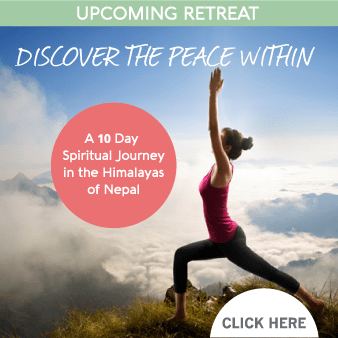
In just a few days time, I’m voluntarily giving up speaking, reading, writing, technology, sleeping in a comfy bed, eating dinner and having the freedom to do anything else other than sit (often painfully!) for more than 10 hours a day in meditation…for 10 days straight!
What may sound even weirder, is that this will be the second time I’ve signed myself up for this…the first time I did it was about a year and a half ago in Cambodia and this time it will be in the mountains of Nepal.
No I am not a masochist, though it was probably the hardest thing I’ve ever done…but it was also the most profound… But to tell the truth I came SOOO close to walking out altogether on day 6, during one of my “storms”…more on that below…
Straight From the Buddha…
This type of meditation is known as Vipassana, a technique handed down directly from the Buddha that was lost in India and other Buddhist countries for a long time, until it was recently rediscovered in Myanmar. Over the last few decades it has been spreading around the world and is taught in retreat format thanks to Goenka, a now deceased Indian man who wanted to spread this incredible teaching.
It’s also known as insight meditation, because unlike other forms of meditation that mainly just help you to calm down or bliss out, insight meditation is designed to change the way you live your life and to eradicate the root causes of suffering…you learn to see for yourself the true nature of reality (impermanence) and how you create your own suffering through the mental states of clinging and aversion. It is also the foundation of modern day “mindfulness” meditation.
What’s the Big Deal??
The first 4 days (!) are spent experiencing the sensations of the breath at the nostrils so that your mind can sharpen and focus, before you learn the full technique which is a body-scan type meditation, where you observe without judgement the sensations in your body.
I must admit, I was a bit skeptical about the technique for awhile, I kept thinking “what’s the big deal with these sensations?”.
But I got it eventually, and the technique did indeed deliver a wealth of insight. As Buddha taught, because we have a body/mind, everything we perceive reaches us through some form or another via sensation. (Thoughts also produce subtle sensations). We constantly react to these sensations by clinging to what we judge as pleasant or resisting what we judge as unpleasant. By observing these reactions, we can start to see how we react to life on a larger scale, and we can deeply understand impermanence and suffering.
Dealing with Pain…and Bliss
A simple example: on day 3 or 4, all the sitting was really getting to me and my back, neck, shoulders and chest were so full of tension and pain I could hardly draw a breath. My mind was resisting and rebelling majorly, I was so identified with the pain, I almost felt like I was trapped inside it, and I really didn’t think I could keep sitting. At some point however, something clicked and I realised that I could watch the pain impartially without reacting mentally with resistance, and without “taking it personally”. And then a strange thing happened…the pain was still there, but it was as if my consciousness drew right back so that it was almost as if I was just watching the pain on a screen (if that makes sense!), like it was happening yes, but it wasn’t happening to me…and I felt completely calm and at peace. I wasn’t identified with the pain anymore, it wasn’t really happening to “me”, because after all, at the subtlest level, who am I but simply awareness? I could still feel it, but it no longer bothered me – I experienced equanimity in the midst of pain.
At other times the sensations in my body were very peaceful and blissful, and I observed my mind attaching and clinging to them…wanting them to last, which is of course another form of suffering and resisting what is. The constant changing of sensations really does teach you at a visceral level about impermanence and equanimity…whether pleasant or unpleasant, all sensations (indeed everything in life) arise and pass away, but we suffer when we resist this natural fact of life by trying to reject the unpleasant and hold onto the pleasant. Peace of mind is possible with the so-called “good” and the “bad” if we can just surrender to, and accept what is.
But let me get one thing straight – it’s not like you figure out how to be equanimous and then it’s all smooth sailing from there…(which I naively thought on day 4…ha ha, pride does go before a fall!) The technique brings up old unresolved samskaras, physical/emotional blocks from old resistances we have been carrying. If you are familiar with Eckhart Tolle’s description of the pain-body, well, that gets activated big time. Goenka called it “passing through storms”, and all sorts of repressed stuff comes up and your mind can become pretty crazy and out of control as you continue with your old habits of resistance.
My Big Freak-Out on Day 6…
One of my storms happened on day 6, the day after we learned the full technique. A lot of strong emotions had been coming up all day and then I felt like my number one concern – that an old back injury may reactivate with all the sitting – was playing up. Although I had had a lot of pain up until then, I knew it was just superficial tension, but on day 6 I started feeling a bit twingey in my disc. My mind went into full-on panic mode – how could I continue with 5 more days? If my disc gets inflamed, it can take months to heal – what should I do? I didn’t want to quit but I didn’t want to hurt myself either and the whole thing was really upsetting me. Thankfully, I had heard from previous participants that a lot of psychosomatic stuff can come up on day 6 and that it’s important to just get through that day in particular without leaving. But my mind was so filled with worries and fears I couldn’t imagine getting through the rest of the day let alone the next 5!
I made myself get a grip. I reigned in all my worries about if it was serious and all my ‘what-if’ thoughts. I remembered that sensations arise and pass, and that it may just pass. I also promised myself to take it one hour at a time – if it still felt bad after an hour or at any point, I could leave if I really wanted to. This calmed me down and I took the rest of the day just one hour at a time, moment by moment, giving myself permission to leave if I really needed to. Thankfully, it was just a samskara, and not my injury playing up – once I got a hold of myself mentally and kept meditating the pain did pass away and I broke on through to the other side.
Jeckyll and Hyde
The rest of the time I seemed to alternate between deep peace and equanimity to all sorts of storms and resistances, including doubt about the technique and extreme drowsiness. Each time I went back to my room during the 5 minute breaks I felt like a different person going in there – it was so changeable from one hour to the next! What I ultimately learned though, was that my experience was truly up to me. If my “head was in it” I was focused and accepting of whatever was happening and experienced deep peace and serenity no matter how I was feeling…if I resisted then pain, drowsiness, frustration and boredom could get the better of me and I suffered. What a powerful lesson to learn in life – it is all up to me!
As amazing and insightful as the 10 days were however, they are but a tiny step on the path of this deep wisdom, practice needs to be continued if it is to transform your everyday life. Goenka recommends 2 hours of practice a day upon returning home, one in the morning and one in the evening, as well as five minutes before bed. I did keep up the 2 hours for awhile, but since then it has been more like 45 minutes most days, along with mixing in a few other practices.
So now I am going in for round 2 to go deeper and to cement the practice even further…despite knowing what to expect in terms of the structure of the retreat and the technique, I have no idea what storms may be waiting for me this time and how I will react – all I can do is be willing to surrender no matter what comes up…
I will write a post when I’m out about my second experience, but in the meantime if you happen to think of me when I’m in there, please send me good vibes and strength to get me through!!
And if you are thinking of doing one yourself, I highly recommend it – they have centres all over the world and you can find upcoming retreats at https://www.dhamma.org.
Namaste <3














Hi Sharee, I will be with you on this retreat. I am waiting for a double full knee replacement surgery in January and have periods of excruciating pain. I am taking to heart what your insights as do rethinking this pain and it is interesting they I am also doing the online Cslmer Mind course at this time. I will be with you in spirit and think of you as you go into your retreat. Namaste Sally
Thank you so much Sally, you will be in my thoughts too – we can support each other! Namaste 😊